
Andy Lloyd's Dark Star Blog

Blog 51 (June 2017)
The Sun was Born with a Companion
Binary star systems are very common, which is one of the reasons why there have been suspicions that out there, somewhere, there may lurk an unseen companion to the Sun, yet to be directly detected. The name Nemesis has been attached to this hypothetical body - the dark nature of the name chosen to reflect a popular theory in the 1980s that Nemesis periodically sent comet swarms our way from its distant abode in the outer Oort cloud. Nemesis (likely a sub-brown dwarf of several Jupiter masses) has not yet been discovered, despite sky searches using infra-red telescopes like IRAS and, more recently, WISE. Still, absence of evidence is not entirely evidence of absence, although the more these searches flag up 'nothing to see here', the more likely that the Sun really is a solo stellar object.
However, it's becoming clear that stars like the Sun do actually form with companion objects (1). Stars are born inside egg-shaped cocoons called 'dense cores'. These Cosmic Eggs are found within stellar nurseries - immense clouds of cold, molecular hydrogen which are often dark and opaque to visual telescopes. Astronomers have to use radio telescopes to study their contents. These observational studies show that the younger the stars within these nebulae, the more likely they are to be binary stellar objects. This has been predicted by some theoretical simulations showing that stars like the Sun tend to form as binary pairs (2).
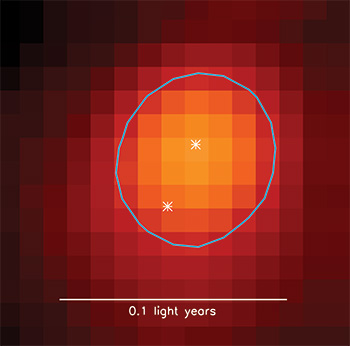
A very young, wide binary star system
Image credit: Sarah Sadavoy, CfA
Recent observations of star formation in the Perseus molecular cloud, using the Very Large Array of radio telescopes in New Mexico and the SCUBA-2 survey in Hawaii, have confirmed the binary nature of initial star formation within the dense cores:
"Most embedded binary systems are found toward the centres of their parent cores, although several systems have components closer to the core edge. Wide binaries, defined as those systems with physical separations greater than 500 au, show a tendency to be aligned with the long axes of their parent cores, whereas tight binaries show no preferred orientation... In the model that best explains the observations, all stars form initially as wide binaries. These binaries either break up into separate stars or else shrink into tighter orbits." (3)
Perhaps a third possibility should be added: That some stars retain these wide binary objects over the long-term, at varying distances. In the case of formation of brown dwarf companions, then theoretical work has shown that these can quite readily be transported into highly eccentric orbits around the parent star, as well as facing possible ejection from the young system (4).
These new observations of extremely young planetary systems imply that most, if not all, star systems start out as binaries, or multiple-star systems. That has implications for the concept of a solar companion:
"“We are saying, yes, there probably was a Nemesis, a long time ago,” said co-author Steven Stahler, a UC Berkeley research astronomer." (1)
According to this new thinking, Nemesis might have formed about 500AU away from the Sun, before being ejected from the solar system in the early chaos.
That kind of distance is in the same ballpark as the proposed 'gas dwarf' Planet Nine (5), although at only ~10 Earth masses, this object could hardly be classified as a stellar companion. One would need to pitch the companion object up about a thousand times to a multi-Jupiter mass sub-brown dwarf, at the very least. But the Planet Nine proposal is at least consistent with this idea of a wide orbit companion, and P9 creates a whole raft of headaches for astrophysicists regarding its origins. The idea that stars begin life with a wide binary companion as a matter of course opens up some possibilities about the nature of the interstellar realm beyond the heliopause. It can't have been just empty space, set well beyond the Sun's protoplanetary disk/accretion cloud. Perhaps Planet Nine started life as a world orbiting that early companion, and became separated from it during the companion's eventual ejection? Or perhaps this companion is still out there, and the effect created by the proposed Planet Nine is a misinterpretation of the perturbing influence of a larger, more distant object. Essentially, that of the Sun's sub-brown dwarf companion.
Written by Andy Lloyd, 15th June 2017
References:
1) Robert Sanders "New evidence that all stars are born in pairs" 13 June 2017, with thanks to Mattia and Amanda
2) Pavel Kroupa "The universality hypothesis: binary and stellar populations in star clusters and galaxies" Computational Star Formation, Proceedings IAU Symposium No. 270, 2011,
3) Sarah Sadavoy & Steven Stahler "Embedded Binaries and Their Dense Cores" MNRAS, 469: 4, 28 April 2017,
4) Ingo Thies et al. "Tidally Induced Brown Dwarf and Planet Formation in Circumstellar Disks" The Astrophysical Journal, 717(1): pp 577-585, July 2010
5) Konstantin Batygin & Michael Brown "Evidence for a Distant Giant Planet in the Solar System" The Astronomical Journal, 151:2, 20 January 2016,
New Arguments about Planet Nine Cluster
The case for Planet Nine was made last year by Drs Mike Brown and Konstantin Batygin of Caltech. They studied a cluster of extended Scattered Disk Objects (SDOs) beyond the Kuiper Belt, whose orbital properties showed significant common ground. They noted that these distant objects showed profoundly similar arguments of perihelion (1). This was no coincidence, argued the Caltech astrophysicists, and they concluded that a substantial planet lay undetected beyond these worlds, shepherding them into their peculiar orbits.
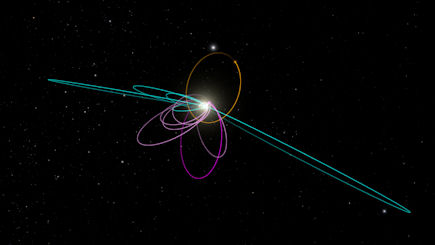
The original ETNO cluster inferring Planet Nine
The hypothesis that a sizeable Planet X body lies out there is hardly new, but is usually considered a toxic subject by most astronomers, who, on the whole, have been sceptical that such a body could have formed in the first place and, if it had, remain undetected for so long. Suddenly, an eminent planet hunter had claimed he had found theoretical proof for the existence of Planet X. To detoxify the subject, and make his theoretical discovery more palatable for a sceptical scientific community, he rebranded the object as Planet Nine. The story took off.
There followed a great many academic papers from various research groups, keen to understand the nature of Planet Nine - as well as hoping to pin it down and observe it directly. I have described a great many of these published articles over the course of the last 18 months or so on this blog, some of which have shored up the case for an unseen Planet X body lying somewhere out towards the inner Oort Cloud. The crux of the argument for Planet Nine hinges upon the validity of the cluttering effect of these particular extreme trans-Neptunian objects (ETNOs - an equivalent term for the extended SDOs), and whether their common properties might be shared with new scattered disk objects as they are discovered.
The existence of a substantial Planet X body would explain a great many anomalies within the solar system, but those anomalies can often also be explained by other phenomena, too. So, the fact that there anomalies does not prove the existence of Planet X, but simply provides a reason to consider the perturbing planet's presence as a common factor.
The Caltech team's Planet Nine paper showed that a statistical analysis of the orbital properties of the clustering of extended SDOs put the possibility of a coincidence well beyond reach. However, the cluster represented quite a small sample of the tiny icy worlds beyond Neptune (even if their collective properties were already very unusual). As such, more data is needed, in the form of further future discoveries of similar objects. The discovery of other, similar extended objects showing no common ground with the cluster would weaken the statistical case for there being a clear effect at work.
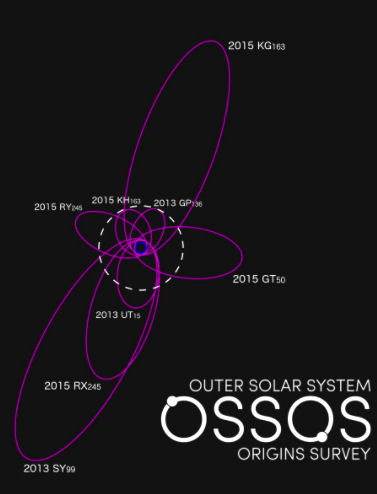
Image credit: OSSOS
Astronomers from Outer Solar System Origins Survey (known as OSSOS) have been busy discovering more Kuiper Belt Objects, and in amongst their recent haul they have identified eight new ETNOs. They argue that these new objects should align with the extended SDO cluster, if Planet Nine's existence is to be believed (2). Although there is potential for a fit with some of these new objects, one of them (2015 GT50) is clearly out of sync with the purported cluster. OSSOS scientists have argued that this brings the claim for a Planet Nine body into doubt, and that the clustering effect could be attributable to observational bias. However, some of the astrophysicists who first noticed the clustering are, in return, sceptical that this marks the claimed death-knell for Planet Nine:
"“I think it’s great work, and it’s exciting to keep finding these [extended SDOs]
,” says Scott Sheppard, an astronomer at the Carnegie Institution for Science in Washington, D.C., who was among the first to suspect a large planet in the distant solar system. But he says three of the four new objects do have clustered orbits consistent with a Planet Nine. The fourth, an object called 2015 GT50, seems to skew the entire set of OSSOS worlds toward a random distribution. But that is not necessarily a knockout blow, he says. “We always expected that there would be some that don’t fit in.”" (3)Stepping back from the entertaining fist-fight that is going on here, the arguments hinge on whether the observed clustering effect is simply a product of observational bias to do with the positioning of, and atmospheric conditions around, key observatories. This is despite the fact that these ETNOs were discovered by different surveys and observatories, which, on the face of it, should preclude such bias. The OSSOS team recognise this:
"The accumulating, but small, set of large semi-major axis trans-Neptunian objects (TNOs) shows an apparent clustering in the orientations of their orbits. This clustering must either be representative of the intrinsic distribution of these TNOs, or else arise as a result of observation biases and/or statistically expected variations for such a small set of detected objects. The clustered TNOs were detected across different and independent surveys, which has led to claims that the detections are therefore free of observational bias. This apparent clustering has led to the so-called "Planet 9" hypothesis that a super-Earth currently resides in the distant solar system and causes this clustering...
"We demonstrate the striking and non-intuitive biases that exist for the detection of TNOs with large semi-major axes. The eight large semi-major axis OSSOS detections are an independent dataset, of comparable size to the conglomerate samples used in previous studies. We conclude that the orbital distribution of the OSSOS sample is consistent with being detected from a uniform underlying angular distribution." (2)
So, the OSSOS team argue that their new data set of ETNOs shows a random distribution, seemingly unaffected by any outside influence by a Planet X body. They then argue that observational bias is indeed a stumbling block for Planet Nine advocates, despite the varied provenance of the original cluster's discoveries. The key object for their argument is 2015 GT50.
Hot on the heels of this OSSOS release is a paper from Spain which describes a previously unnoticed correlation between nodal distance and orbital inclination for the extreme trans-Neptunian Objects:
"This proposed correlation is unlikely to be the result of observational bias as data for both large semimajor axis Centaurs and comets fit well into the pattern found for the ETNOs, and all these populations are subjected to similar background perturbations when moving well away from the influence of the giant planets. The correlation found is better understood if these objects tend to avoid a putative planet with semimajor axis in the range 300-400 au." (4)
This new work may bolster the case for Planet X if it, too, isn't attributable to observational bias, as the researcher argue. It seems likely that we're about to see a new rash of Planet X science papers appear as this debate heats up. Let us take a ringside seat and watch as things kick off!
Written by Andy Lloyd, 23rd June 2017
References:
1) Konstantin Batygin & Michael Brown "Evidence for a Distant Giant Planet in the Solar System" The Astronomical Journal, 151:2, 20 January 2016,
2) Cory Shankman et al. "OSSOS VI. Striking Biases in the detection of large semimajor axis Trans-Neptunian Objects", The Astronomical Journal, 154(2): 50, 4 July 2017
3) Josh Sokol "New haul of distant worlds casts doubt on Planet Nine", 21 June 2017
4) C. de la Fuente Marcos & R. de la Fuente Marcos "Evidence for a possible bimodal distribution of the nodal distances of the extreme trans-Neptunian objects: avoiding a trans-Plutonian planet or just plain bias?" Monthly Notices of the Royal Astronomical Society: Letters, 471: 1, 21 Jun 2017
Warping of outer solar system indicates presence of Planet X
Scientists at the University of Arizona have made a discovery about the outer reaches of the Kuiper Belt, an extensive asteroid belt beyond Neptune. Objects that populate the main body of this belt have orbital tilt inclinations to the ecliptic (the main plane of the planets) which pretty much average themselves out. Several studies have been carried out to measure the mean plane of the Kuiper Belt (centred around 40AU), which have generally arrived at this same uneventful conclusion. However, since these previous studies were conducted, there have been a rash of discoveries of new Kuiper Belt Objects beyond the Kuiper Cliff - where the belt becomes truncated around 55 astronomical units (AU). This new work seeks to determine whether these new, more distant objects fall into line with the bulk of the Kuiper Belt, or whether there is a deviation from that established norm.
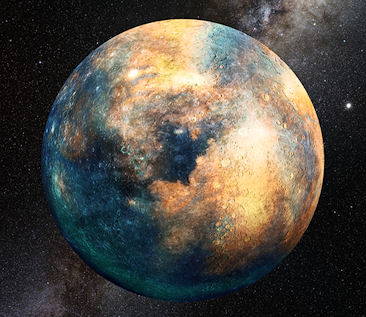
Image credit: Heather Roper/LPL
The more distant objects in the belt (the extended KBOs beyond the 'Kuiper Cliff', also known as extended scattered disk objects) show a deviated value for their averaged spin axes, creating a mean plane for the extended disk pitched at about 9 degrees to the ecliptic (1). This is an unexpected finding, and too great a value to be attributable to a statistical blip. The authors of the new paper argue that this unexpected distribution has important implications for the dynamical history of the outer solar system. The anomaly calls for the presence of a perturbing body to explain this significant deviation from the ecliptic of these extended KBOs.
According to Kat Volk and Renu Malhotra, of the UA's Lunar and Planetary Laboratory, a planetary mass object the size of Mars, or perhaps larger, would be sufficient to produce the observed perturbations in the distant reaches of the Kuiper Belt:
"If one were to think of the average orbital plane of objects in the outer solar system as a sheet, it should be quite flat past 50 AU, according to Volk. "But going further out from 50 to 80 AU, we found that the average plane actually warps away from the invariable plane," she explains. "There is a range of uncertainties for the measured warp, but there is not more than 1 or 2 percent chance that this warp is merely a statistical fluke of the limited observational sample of KBOs."
In other words, the effect is most likely a real signal rather than a statistical fluke. According to the calculations, an object with the mass of Mars orbiting roughly 60 AU from the sun on an orbit tilted by about eight degrees (to the average plane of the known planets) has sufficient gravitational influence to warp the orbital plane of the distant KBOs within about 10 AU to either side.
"The observed distant KBOs are concentrated in a ring about 30 AU wide and would feel the gravity of such a planetary mass object over time," Volk said, "so hypothesizing one planetary mass to cause the observed warp is not unreasonable across that distance."" (2).
They don't think this warping of the outer solar system beyond the Kuiper Cliff is likely to be due to Planet Nine. Instead, they favour a solution involving a smaller, terrestrial Planet X body located less than 100AU away. Or maybe more than one Planet X. Or a relatively recent close brush with a passing star which set off all the extended KBOs into a collective series of disturbed spins, which they're slowly all adjusting back from. There are so many possible scenarios on the table now, each grappling with a set of complex constraints from the amassing data from the outer solar system, as well as increasingly accurate astrometry of the planets (which should themselves show finely tuned perturbation by a distant unseen planet).
Another alternative, which has not been discussed in the press release (2), or in the scientific paper, as far as I can see (1), is that a more substantial Planet X body has a highly eccentric orbit which periodically brings it within range of the Kuiper Belt. Let's say, for instance, that Planet X spends the vast majority of its long orbit in the vicinity of the inner Oort Cloud, but approaches the outer Kuiper Belt by achieving perihelion at, say, 80AU. That would explain, quite neatly really, why there is such a significant gap in bodies between the Kuiper Cliff (~55AU) and the inner Oort Cloud (~2000AU). This area is swept out by the highly eccentric orbit of Planet X, creating the anomalies in the extended scattered disk, as well as accounting for the lack of observed sighting of the object (assuming, reasonably, that it is currently near aphelion).
Written by Andy Lloyd, 30th June 2017
References:
1) K. Volk & Renu Malhotra "The curiously warped mean plane of the Kuiper belt", Astronomical Journal, 154: 2, (2017)
2) Daniel Stolte, University of Arizona Press Release "UA Scientists and the Curious Case of the Warped Kuiper Belt" 20 June 2017,
~~ * ~~
Here's an interesting idea from correspondent Roger Curnow, which could neatly wrap up a lot of material. Not sure it's practical on some levels, but worth considering all the same:
"In your Blog, you suggest that the “Kuiper Cliff” is caused by the presence of the Dark Star (DS) at a perihelion of 80 AUs. Perhaps 80 AUs is not the perihelion, but is instead where DS crosses the Ecliptic, the ascending and descending nodes of DS's orbit. The perihelion would then be much closer, perhaps as close as the Asteroid Belt (AB), but far to the south of it. The orbit of its outermost moon, Nibiru, depending on its inclination to that of DS, might then occasionally intersect the AB." (3)
3) Correspondence from Roger Curnow, Milton, Florida, received 6 July 2017
Jupiter's Role in the Early Solar System
Astronomers studying proto-planetary disks encircling young stars have been lucky enough on occasion to spot the tell-tale trails of young planets accreting within. These early planets in fledgling star systems can show how quickly the rotating building materials around young stars can form planetessimals. It's not unreasonable to assume, therefore, that our own gas giant planets, Jupiter and Saturn, formed early on too, re-shaping the proto-planetary disk as they absorbed more and more materials, and migrated across large swathes of the early solar system.
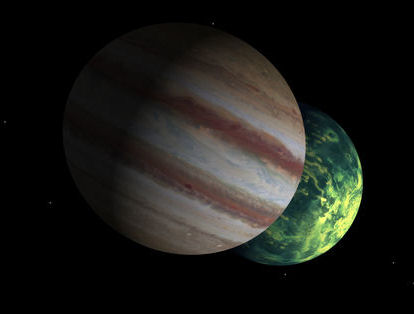
Studies of the isotopic ratios of materials in meteorites has helped astronomers to build a theoretical picture of the early solar system - a system divided in two by Jupiter. The conclusion they have now drawn from their deductive reasoning is that Jupiter was the earliest of the Sun's family of planets to form, just 1 million years after our star herself (1). By comparison, the Earth is thought to have formed about 50 million years later.
Jupiter's effect upon the early solar system is now considered to have
been catastrophic in nature. Its sheer size enabled it to crush or
eject other fledgling worlds, including, potentially, a third gas giant:
"The great Jovian beast is also thought to have
taken out another gas giant. About 4 billion years ago, 600 million
years after the sun's first light, some astronomers think there was a
third gas giant in the solar system that had formed along with Jupiter
and Saturn. By studying the orbits of Jupiter's moons, researchers have
concluded that this third gas giant may have strayed too close to
Jupiter before settling into a stable orbit. In an immense gravitational
encounter, Jupiter, swollen with gas and rage, ejected the third gas
giant from the solar system entirely, sending it hurling out into the
frigid realms of interstellar space as an orphan planet." (2) Although this may look like an interesting piece of
evidence for early cosmic catastrophe, the study involving Jupiter's
moons was essentially calculations to rule out whether they would have
been unduly affected by such an early encounter. The study
concluded that the current orbits of Jupiter's moons could be consistent
with such an early event, but not so much with Saturn's (3).
That's not to say that this is what happened with Jupiter, only that it
could be ruled out in the case of Saturn. Anyhow, it's interesting that Jupiter seems to have
emerged so early on in the Sun's past, when considered alongside the
likelihood that the Sun started out with a wide binary companion?
It has been suggested to me that perhaps Jupiter was originally a
sub-stellar companion, eventually driven into its current, tighter
orbit. This might be in keeping with one of the modes of
disappearance of an early binary companion, as suggested by Sarah
Sadavoy & Steven Stahler, the astronomers from Berkeley who have firmed
up the binary universality hypothesis with some direct observations (4,5). More likely, though, is that Jupiter did indeed form within
the Sun's own proto-planetary disk, but this took place alongside a
quite separate formation of a sub-stellar companion with the Sun within
the Cosmic Egg dense core.
Written by Andy Lloyd, 15th June 2017
References:
1) Thomas Kruijer et al. "Age of Jupiter inferred from the distinct genetics and formation times of meteorites", Proceedings of the National Academy of Sciences, 4 May 2017, with thanks to Korbyn
2) Jay Bennett "Jupiter's a Jerk" 17 May 2017
3) Ryan Cloutier, Daniel Tamayo & Diana Valencia "Could Jupiter or Saturn Have Ejected a Fifth Giant Planet?" The Astrophysical Journal, 17 September 2015,
4) Sarah Sadavoy & Steven Stahler "Embedded Binaries and Their Dense Cores" MNRAS, 28th April 2017,
5) Andy Lloyd "The Sun was Born with a Companion" 15th June 2017 (see above)
Humans emerged 300,000 years ago, across Africa
Last month, I wrote about the re-dating of Homo naledi hominins, who now appear to have lived in southern Africa some 300,000 years ago (1). This was around the same time that early humans were emerging as a species - the timing of which has been supported by further evidence of human remains excavated at a site in Jebel Irhoud in Morocco (2):
"The idea that modern people evolved in a single "cradle of humanity" in East Africa some 200,000 years ago is no longer tenable, new research suggests. Fossils of five early humans have been found in North Africa that show Homo sapiens emerged at least 100,000 years earlier than previously recognised. It suggests that our species evolved all across the continent, the scientists involved say." (3)
The remains are dated to between 300,000 and 335,000 years ago, and are almost identical to modern humans. Evidence from the site suggests tool and fire use.
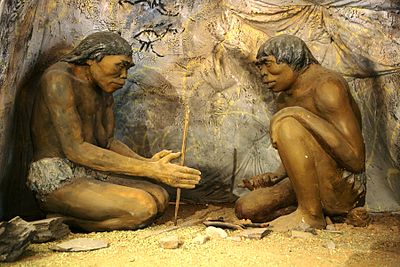
Image Credit: National Museum of Mongolian History in Ulaanbaatar, Mongolia.
It's clear that the emergence of humans, and our archaic cousins, is becoming increasingly complex. Long-gone is the nice linear evolutionary picture of old, whereby Homo sapiens neatly sprang from an earlier proto-human hominin in east Africa, then slowly spread out from there across the globe. (The term ‘hominin’ may be defined as ‘humans and their non-ape ancestors’). Instead, the range of ancient sites across Africa provides a different picture of multiple branches of broadly parallel evolution on the continent over, extending back in time to perhaps as long ago as half a million years. Evidence of archaic Homo sapien-like remains have also been dug up outside Africa:
"Prof Chris Stringer from the Natural History Museum in London... raises the possibility that Homo sapiens may even have existed outside of Africa at the same time: "We have fossils from Israel that are probably the same age and they show what could be described as proto-Homo sapiens features."" (3)
Evidence of humans using fire over 300,000 years ago emerged a few years ago when a new road was being prepared for construction near Tel Aviv in Israel (4). Remarkably, the dating of the Qesem cave could set the human clock as far back as 400,000 years:
"Researchers thought remains including scattered deposits of ash, clumps of soil that had been heated to high temperatures, and the remains of large animals, had been left by pre-historic cave dwellers up to 400,000 years ago. A 2010 study into the traces caused controversy in the archaeology world as it questioned the theory of Homo sapiens originating in Africa, but the archaeologists were unable to draw a concrete conclusion from the evidence." (5).
The use of fire by various hominins may extend back much further, perhaps as far back as 1.5 million years (6). Changes in dentition indicate that our archaic ancestors Homo erectus made use of fire for cooking almost 2 million years ago (7), which seems to have been a crucially important development at an unexpectedly early stage in our biological evolution:
"... three species of humans, Homo erectus, Neanderthals, and modern humans, evolved small molars relatively quickly, which could not be explained by general changes in head and jaw sizes. Instead, ...the invention of cooking could explain the changes in both tooth size and feeding times. As early humans learned how to cook, they no longer needed large back teeth to chew tough food, or had to spend hours chewing to gain enough calories. Over time, large teeth disappeared from our ancestors, to be replaced with far smaller ones." (8)
So, the controlled use of fire was well established among hominins long before modern humans emerged, even if that timeline is shifting backwards to several hundred thousand years. These erratic, gradualist developments among proto-humans offer challenges to Sitchin's ideas (9) for a rapid emergence of a technologically more capable human species through genetic engineering intervention. The breeding ground for modernity seems to be widespread, both geographically and temporally. The changing chronology of early humans emerging about 300,000 years ago helps Sitchin's case. The variation in development among divergent pockets of human populations is less easy to explain within his theory. But, then science is having its own headache over this, too.
Written by Andy Lloyd, 10th June 2017
References:
1) Andy Lloyd "Caves of the 'Star Man'" 12 May 2017
andylloyd.org/darkstarblog50.htm
2) Jean-Jacques Hublin et al. "New fossils from Jebel Irhoud, Morocco and the pan-African origin of Homo sapiens" Nature, 546, pp289–292, 8 June 2017,
3) Pallab Ghosh "'First of our kind' found in Morocco" 7 June 2017
4) R. Shahack-Gross et al "Evidence for the repeated use of a central hearth at Middle Pleistocene (300 ky ago) Qesem Cave, Israel", Journal of Archaeological Science, 44, April 2014, pp12–21,
5) Kashmira Gander "300,000-year-old firepit found in Israel could be the first example of a social campfire" 28 January 2014
6) J. Gowlett "The discovery of fire by humans: a long and convoluted process", Philosophical Transactions of the Royal Society B, 371: (1696), 5 June 2016,
7) Chris Organ et al "Phylogenetic rate shifts in feeding time during the evolution of Homo" PNAS, 108: 35, 14555–14559, 26 July 2011,
8) Ian Sample "Cooking may be 1.9m years old, say scientists" 22 August 2011,
9) Zecharia Sitchin "The Twelfth Planet" Avon Books 1976
Nibiru: The Role-Playing Game
I had the pleasure of meeting Fredrico Sohns over the weekend, who was publicising his new role-playing game 'Nibiru' at the U.K. Games Expo at Birmingham's NEC. The science fiction game involves the recollection of lost memories, and features some superb artwork (1).
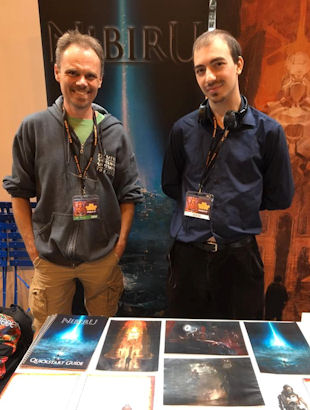
Andy Lloyd and Fredrico Sohns.
Image Credit: Dave Cosnette
Besides the mention of 'Enki's Covenant' in the game, 'Nibiru the RPG' is not a Sitchinite construct, according to Fredrico. Instead, Nibiru in this game alludes to a visiting realm, more akin to an enormous alien spaceship. Players in the game awake within this exotic sci-fi realm, and must navigate it in the hope of retrieving their lost memories. In so doing, they build up their abilities and prowess as characters, more capable of dealing with the challenges the various habitats within Nibiru have to offer.
The game is still in its development stages, with the hope of obtaining funding through gamer crowd-sourcing, via Kickstarter, later this year. The stall Fredrico ran at the Expo aimed to raise the profile of the game, and give punters the chance to quickly sample its game-play.
Best of luck to him and the rest of the Nibiru team as they progress with this exciting project!
2021 Update: 'Nibiru: A Science Fiction Game of Lost Memories' has now been published by Pandemonium Books and Games
Written by Andy Lloyd, 7th June 2017
References:
1) Nibiru - A Sci-Fi RPG of Lost Memories
![]() Buy your copy through through
Amazon.com here:
Buy your copy through through
Amazon.com here:
![]() Buy your copy through through Amazon.co.uk here:
Buy your copy through through Amazon.co.uk here:

You can keep informed of updates by following me on Twitter:
![]()
Or like my Facebook Page: https://www.facebook.com/darkstarandylloyd